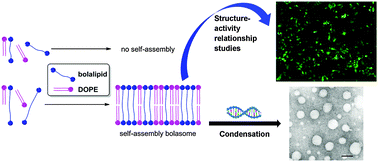Structure–activity relationship studies of symmetrical cationic bolasomes as non-viral gene vectors†
Abstract
Compared to traditional cationic lipids, bola-type lipids have received much less attention despite their advantages including the ability to form more stable and regular-shaped liposomes. In this report, a series of novel symmetric cationic bolalipids based on lysine or cyclen headgroups were designed and synthesized. Structure–activity relationships including the effect of the hydrophobic chain length and cationic headgroup on liposome formation, DNA binding, the physical property of bolasomes, and gene transfection were systematically studied. Results reveal that an appropriate hydrophobic chain length is essential to form nano-sized bolasomes with good DNA binding and condensation ability. MTS-based cell viability assays showed low cytotoxicity of these bolasome/DNA complexes. Lys-14-10, which has a 36-atom-length hydrophobic chain, exhibited the best transfection efficiency in the two cell lines. Flow cytometry and confocal laser microscopy assays reveal that the bolaplexes formed from bolalipids with such a chain might induce the highest cellular uptake. For the cationic headgroup, lysine is more suitable than cyclen for such a bola-type vector. Although the TEs of these bolalipids are still lower than commercially used non-bola lipid lipofectamine 2000, this study may give us some clues for the design of novel bolalipids with higher TE and biocompatibility.


 Please wait while we load your content...
Please wait while we load your content...